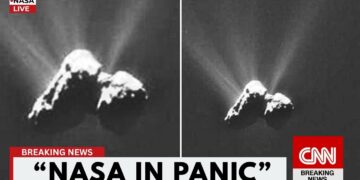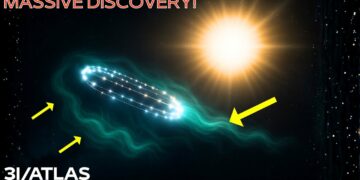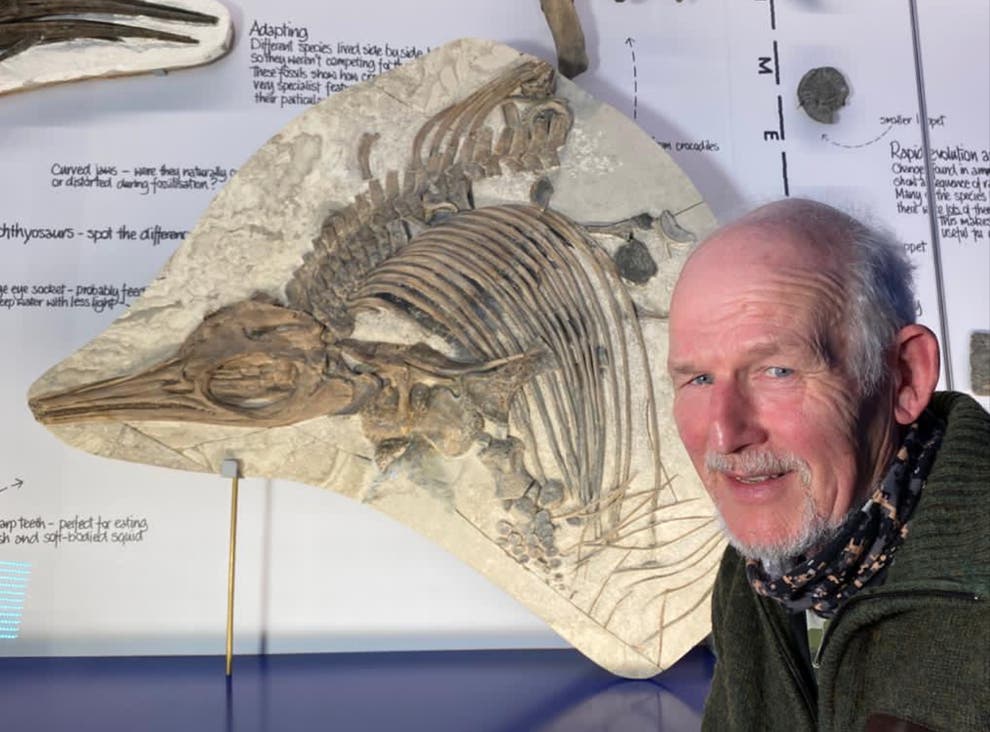The James Webb Space Telescope’s first clear image of 3I/Atlas is more than a milestone in astronomy—it’s a transformative moment in our quest to understand interstellar wanderers that drift through our solar system. Until now, these objects, with 3I/Atlas being only the third confirmed interstellar visitor, were fleeting blips, barely captured by telescopes before vanishing into the cosmic void. Webb’s high-resolution image offers unprecedented clarity, both visually and scientifically, unveiling features that spark awe and curiosity. This is not just a picture; it’s a window into a cosmic stranger’s story.
A massive object, roughly the size of Manhattan, is hurtling toward our solar system at 137,000 mph, set to make its closest pass to Earth on December 17th. Is it a comet, an asteroid, or something else entirely? A Harvard astrophysicist argues there’s a strong case for it being an alien craft, with profound implications for humanity. Unlike the smaller interstellar objects ‘Oumuamua and 2I/Borisov, which were hundreds of times smaller, 3I/Atlas is estimated at 20 kilometers wide based on its brightness, assuming it reflects sunlight like a solid object. Its size—larger than Manhattan Island—and its trajectory, perfectly aligned with the plane of our solar system’s planets, raise questions. Why is the third interstellar object so much larger than its predecessors, with no intermediate sizes observed? This anomaly, combined with its precise path, fuels speculation about intelligent design.
Webb’s image, captured with its infrared capabilities beyond Earth’s atmosphere, reveals 3I/Atlas in stunning detail, free from atmospheric distortion. Unlike the blurry glimpses of ‘Oumuamua and Borisov, limited by earlier technology, Atlas appears as a resolvable body with distinct surface features, spectral signatures, and a visible coma of outgassing particles. The surface shows a mix of reflective patches, likely volatile ices sublimating under the sun’s heat, and darker scars hinting at impacts or fractures from its interstellar journey. This duality—part comet, part asteroid—suggests Atlas is a hybrid, possibly born in the outer reaches of a distant star system and ejected by gravitational forces. Its faint halo of gas and dust confirms it retains volatile compounds, making it a pristine sample of interstellar material, a time capsule from another star system.
Webb’s spectrographs reveal a chemical signature blending familiar and alien compounds. Water ice is abundant, but exotic organic molecules, rarely seen in solar system comets, hint at unique chemical processes from a foreign stellar environment. These molecules could be universal seeds of prebiotic chemistry, capable of sparking life on hospitable worlds, strengthening the case that interstellar objects are cosmic couriers of life’s ingredients. At several kilometers wide, Atlas dwarfs ‘Oumuamua’s slender fragment and Borisov’s comet-like form, suggesting it survived a violent ejection from its home system, perhaps triggered by giant planets or a passing star. Its hyperbolic orbit confirms its interstellar origin, passing through our solar system once before departing forever, a fleeting visitor captured in vivid detail by Webb.
Compared to ‘Oumuamua’s odd, elongated shape, which sparked artificial-origin theories, and Borisov’s typical comet behavior, Atlas’s hybrid nature highlights the diversity of interstellar objects. Each visitor offers a unique glimpse into another star system’s history, reflecting the varied architectures of planetary systems across the galaxy. Beyond astronomy, Atlas impacts planetary formation theories, astrobiology, and cosmochemistry. Its kilometer-scale size suggests dynamic planetary systems routinely eject large objects, turning interstellar space into a highway of wandering debris. The presence of exotic organics supports panspermia theories, suggesting life’s building blocks are scattered across the galaxy.
Webb’s image also resonates culturally and philosophically. It makes the galaxy feel intimate, showing a tangible fragment of another star system. For the public, this sharp portrait of Atlas against a starry backdrop is an invitation to ponder cosmic connections—a journey spanning millions of years, etched in rock and ice. Scientifically, it validates Webb’s mission to study both the distant universe and nearby phenomena with unmatched precision. The telescope’s segmented mirror and mid-infrared instruments reveal thermal properties, surface activity, and a chaotic tumbling motion, hinting at Atlas’s violent history. Its patchwork surface, with carbon-rich dark patches and bright icy regions, tells a story of cosmic forces stitching together a geological relic.
This discovery fuels ambitions for future exploration. Intercepting an object like Atlas with a probe could yield direct samples, bridging remote observation and hands-on study. For now, Webb’s image inspires scientists, educators, and dreamers, sparking discussions in classrooms, museums, and policy circles about humanity’s place in the cosmos. It challenges us to rethink interstellar space as a dynamic network of travelers, not an empty void. Atlas, with its scars, ices, and organic molecules, is a messenger from another star, a reminder that our solar system is part of a galactic web of motion and exchange.
The image of 3I/Atlas is not an endpoint but a beginning. As researchers analyze its thermal properties, rotation, and chemistry, Atlas will shape models of galactic dynamics and planetary formation. It underscores the rarity and luck of such encounters, made possible by Webb’s engineering triumph. This solitary traveler, briefly crossing our path, connects us to the broader universe, reminding us that the galaxy is alive with movement, discovery, and stories waiting to be told.























